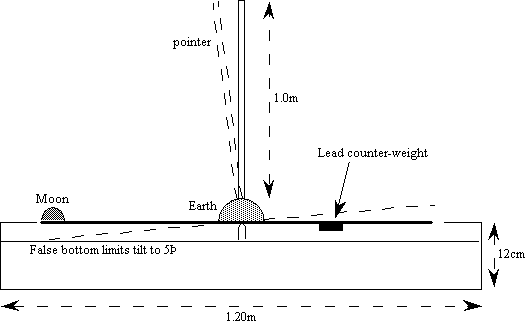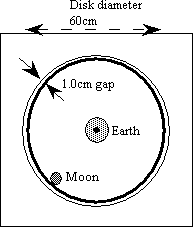Mechanical model of Earth-Moon orbit around Sun.
What it shows:
A model to demonstrate the precession of the Moon's orbit relative to the ecliptic. It is useful for discussing the conditions necessary for the occurrence of an eclipse.
How it works:
A large aluminum disk represents the plane of the Moon's orbit about the Earth. The disk lies flush with the box surface it sits in; the plane of the box representing the Ecliptic. The Moon's own orbit is inclined at 5° to the ecliptic, and precesses with an 18 year period. You can set the disk rotating (it tends to be unstable at high speeds) and with a flashlight or projector representing the Sun, you can see how the precession aligns the three heavenly bodies to produce an eclipse.
The disk is a 3mm aluminum sheet 60cm in diameter. The Earth at the center is an aluminum hemisphere 6cm in diameter with a recessed steel pivot point so the disk pivots above its center of gravity. The precession pointer is a 1m length aluminum rod of 1cm diameter. The Moon, situated at the outer rim of the disk, is a brass hemisphere 2.5cm in diameter. It is counter-balanced with lead on the underside of the disk. The box, constructed of wood, has an inner floor 2.5cm deep allowing the disk to tilt a maximum of 55° to the horizontal. There is a 1cm clearance between the disk and the circular hole in the box.
figure 1. Side view of the Moon Orbit Model
figure 2. Side view of Moon orbit model
Comments:
Although not designed to cast shadows, the use of a flashlight to represent the Sun will aid in showing the conditions for an eclipse, and that a solar eclipse can only occur at a new moon and a lunar eclipse can only at full moon. This model was designed and built by Harvard student Walker Stevenson as a project for Science A-17 in 1982.